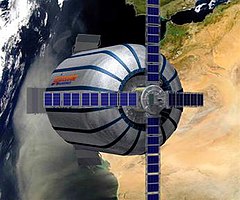Genesis II

Artist rendering of Genesis II
|
|
| Station statistics | |
|---|---|
| COSPAR ID | 2007-028A |
| SATCAT № | 31789 |
| Crew | Unmanned |
| Launch | 28 June 2007, 15:02:00 UTC |
| Launch pad | Dombarovskiy base, Russia |
| Mission status | Retired, on orbit |
| Mass | 1,360 kg (3,000 lb) |
| Length | 4.4 m (14 ft) |
| Diameter | 2.54 m (8.3 ft) |
| Pressurised volume | 11.5 m3 (410 cu ft) |
| Atmospheric pressure | 69.6–72.4 kPa (10.09–10.50 psi) |
| Perigee | 485.1 km (301.4 mi) |
| Apogee | 557.5 km (346.4 mi) |
| Orbital inclination | 64.5° |
| Orbital speed | 7.6 km/s (4.7 mi/s) |
| Orbital period | 95.1 min |
| Orbits per day | 15.15 rev/day |
| Orbit epoch | 21 February 2016, 04:08:06 UTC |
| Days in orbit | 3512 |
| No. of orbits | 47585 |
Genesis II is the second experimental space habitat designed and built by the private American firm Bigelow Aerospace, launched in 2007. As the second module sent into orbit by the company, this spacecraft builds on the data and experience gleaned from its previously orbited sister-ship Genesis I. Like its sister-ship and other modules being designed by Bigelow Aerospace, this spacecraft is based on the NASA TransHab design, which provides increased interior volume and reduced launch diameter along with potentially reduced mass compared to traditional rigid structures.
Genesis II was "retired" when its avionics systems stopped working after two and a half years. It remains in orbit which allows researchers to continue testing the long-term viability of expandable space structures.
Similar to the process endured by Bigelow for Genesis I, transporting Genesis II to Russia for launch was the end result of nearly a year of regulatory processes due to restrictions imposed by International Traffic in Arms Regulations (ITAR) and other procedures, both in the United States and abroad. After leaving North Las Vegas, Nevada in the United States, the spacecraft made a stopover in Luxembourg before being flown on an Antonov An-124 to Orsk, Russia, and transported over ground to the Dombarovskiy base. Genesis II made its final move into the Assembly, Integration and Test Building on 29 March 2007. Originally slated for an 6 August 2006, launch, ISC Kosmotras delayed the launch to 30 January 2007, due to the failure of a Dnepr rocket in July 2006. The launch was delayed an additional four times (1 April 19 April, 26 April, and 23 May) due to technical and scheduling reasons before its eventual launch on 28 June 2007 at 15:02 UTC.
As with Genesis I, it was launched aboard an ISC Kosmotras Dnepr rocket from Dombarovskiy missile base near Yasniy, Russia. It successfully reached orbit after separation from the rocket at 15:16 UTC. Due to the mechanics of its orbit, first contact with the craft was established once it passed over SpaceQuest, Ltd.'s Fairfax, Virginia receiving station at 22:20 UTC, confirming that it was functioning nominally with power and air pressure at expected levels. Externally, Genesis II is identical in size to Genesis I; as such, it is a one-third scale of the full-size BA 330 model, with on-orbit measurements of 4.4 meters (14.4 ft) in length and 2.54 meters (8.3 ft) in diameter, with an interior habitable volume of 11.5 cubic meters (406.1 cu ft). As part of its inflatable design, Genesis II launched with a diameter of 1.6 meters (5.2 ft), expanding to its full size after entering orbit. Within two days of launch, attitude control systems had damped all rotation and oriented antennae toward Earth.
...
Wikipedia
